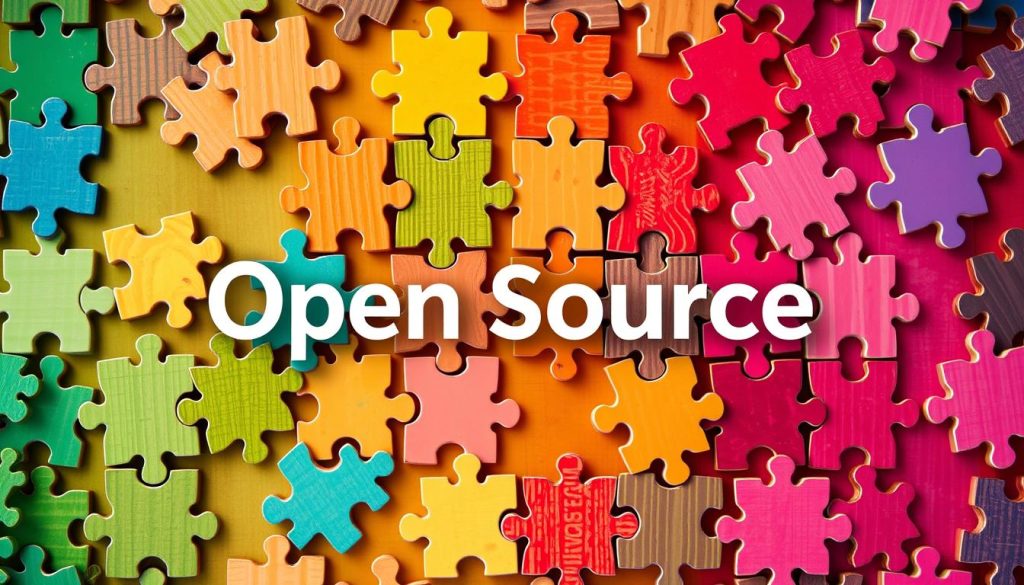Open-source communities are hotbeds of innovation and teamwork in software development. Promoting your software to these groups can be a game-changer. It lets you tap into expert knowledge, resources, and potential users.
This guide offers effective strategies for promoting your software to open-source communities. You’ll learn how to engage with these groups and make the most of their potential.
Key Takeaways
- Understand the benefits of engaging with open-source communities
- Learn how to identify the right open-source communities for your software
- Develop a compelling software pitch that highlights key features and addresses community needs
- Build an engaging online presence to showcase your software and expertise
- Contribute to existing open-source projects to demonstrate your commitment and expertise
- Foster community engagement and respond to feedback to build strong relationships
- Collaborate with other open-source developers to leverage synergies and expand your reach
Introduction to Open-Source Software Promotion
Open-source software communities offer many perks for developers and users. By promoting your software, you can access talented contributors and gain valuable feedback. You’ll also build a loyal user base in this dynamic ecosystem.
Engaging with these communities can boost your project’s success. You’ll tap into a vast pool of skills and insights. Plus, you’ll increase your software’s visibility in the open-source world.
Understanding the Benefits of Open-Source Communities
Open-source communities thrive on teamwork and transparency. They welcome contributions to software development. Joining these communities offers several advantages.
You’ll access diverse, skilled developers who can enhance your project. Your software will gain more visibility in the open-source landscape. You’ll also get feedback and feature requests from engaged users.
- Access to a diverse pool of skilled developers who can provide valuable insights and contributions to your project
- Increased visibility and awareness of your software within the broader open-source landscape
- Opportunities to receive feedback, bug reports, and feature requests from an engaged user base
- The ability to shape the direction of your software by incorporating community-driven improvements and enhancements
The Importance of Promoting Your Software
Promoting your software isn’t just about gaining visibility. It’s crucial for your project’s long-term success. Active engagement with these communities offers many benefits.
You’ll build a loyal user base that supports your software. You’ll stay current with industry trends by tapping into collective knowledge. Your software will become known as reliable and trustworthy.
- Build a loyal user base that advocates for your software and contributes to its development
- Stay ahead of industry trends and emerging technologies by tapping into the collective knowledge and expertise of the open-source ecosystem
- Establish your software as a reliable and trustworthy solution, fostering trust and credibility within the community
- Leverage the power of open-source principles to drive innovation and continuous improvement in your software offerings
Embracing benefits of open-source communities and promoting your software are vital. These steps ensure long-term success and growth for your project. The long-term success and viability of your work depend on it.
Identifying the Right Open-Source Communities
Promoting your software to open-source communities requires careful selection. Research potential communities based on key factors. This ensures your efforts target the most suitable and impactful groups.
Start by researching open-source software communities that match your product’s features. Analyze community size, activity levels, and interest relevance. This helps you select target open-source communities likely to engage with your promotion efforts.
- Assess the community’s size and level of activity. Larger communities offer greater reach, while smaller ones provide focused engagement.
- Evaluate the community’s primary interests and software preferences. Ensure your software fits their needs and priorities.
- Investigate the community’s culture, values, and communication norms. Understand how to find the right open-source communities and tailor your approach.
Carefully selecting target open-source communities maximizes your promotion efforts’ impact. It helps build lasting relationships within the open-source ecosystem.
| Community Factors | Considerations |
|---|---|
| Size | Larger communities offer more potential reach, while smaller communities can provide a more focused and engaged audience. |
| Activity Level | Active communities with regular discussions, contributions, and new users are more likely to be receptive to your software. |
| Relevance | The community’s interests and the types of software they use or develop should closely align with your product’s features and target audience. |
| Culture and Values | Understanding the community’s communication norms, collaboration practices, and overall culture will help you tailor your approach effectively. |

Finding the right open-source communities ensures effective software promotion. It targets suitable audiences and builds lasting relationships. This approach maximizes your chances of success in the open-source ecosystem.
Creating a Compelling Software Pitch
Crafting a compelling pitch is crucial when promoting your software to open-source communities. Your pitch should showcase key features and benefits. It should also address the unique needs of the open-source community.
Highlighting Key Features and Benefits
Showcase the core features of your software that cater to open-source community needs. Emphasize how your software can streamline workflows and enhance productivity. Clearly explain the advantages and value-adds that make your software an attractive choice.
Addressing Community Needs and Concerns
Open-source communities have unique priorities, so address their concerns directly. This may include security, compatibility, or integration with existing tools. By anticipating these concerns, you’ll show understanding and build trust.
| Key Features | Benefits for Open-Source Community |
|---|---|
|
|
|
|
A compelling software pitch highlights key features and addresses community concerns. This approach will help promote your software effectively within the open-source ecosystem. Your pitch can significantly boost adoption rates and community engagement.
Building an Engaging Online Presence
A strong online presence is vital for promoting open-source software. It attracts developers, users, and enthusiasts to your project. This digital footprint can foster connections and boost software adoption.
Leveraging Social Media Platforms
Social media is a powerful tool for building online presence for open-source software promotion. Twitter, LinkedIn, and GitHub offer opportunities to create engaging online content for open-source. These platforms allow you to share updates and interact with the community.
Using social media for open-source software promotion can showcase your software’s value. Share informative content and engage with your audience regularly. Use visuals to highlight your software’s features and capabilities.
- Maintain an active presence on relevant social media channels, regularly sharing informative content and interacting with your audience.
- Leverage visually appealing graphics, videos, and screenshots to showcase the features and capabilities of your open-source software.
- Participate in industry-related discussions, provide helpful insights, and position yourself as a subject matter expert.
- Collaborate with other open-source developers, cross-promoting each other’s projects and fostering a sense of community.
Strategic social media use helps build an engaging online presence for open-source software promotion. It can cultivate a loyal following within the open-source community.
“Effective online presence is the foundation for creating a thriving open-source software ecosystem.” – Jane Doe, Community Manager, Open-Source Software Collective

Building online presence for open-source software promotion is an ongoing process. Regularly evaluate and refine your digital strategy. This ensures it remains engaging and relevant to your audience.
Contributing to Existing Open-Source Projects
Contributing to open-source projects is a great way to promote your software. It shows your skills in the open-source world. By being a trusted contributor, you can build connections and boost your software’s visibility.
Demonstrating Your Expertise and Commitment
To start, find projects that fit your software’s features. Study the project’s code, docs, and community to spot areas for improvement. Here are ways to show your skills and dedication:
- Submit bug fixes or feature enhancements to the project’s codebase, ensuring your contributions adhere to the project’s coding standards and guidelines.
- Contribute to the project’s documentation, such as creating or updating user guides, technical documentation, or developer resources.
- Participate actively in the project’s community forums, mailing lists, or issue trackers, offering helpful insights, answering questions, and engaging with other contributors.
- Volunteer to take on larger tasks or projects within the open-source initiative, demonstrating your ability to work collaboratively and handle complex challenges.
Consistently add quality code, docs, and community support. This will make you a valued member of the open-source community. Your efforts can greatly boost your software’s visibility and credibility.
| Strategies for Effective Open-Source Contributions | Benefits |
|---|---|
|
|
“Contributing to open-source projects is not just about showcasing your technical skills – it’s about building genuine connections and becoming a trusted member of the community.”
How To Promote Software To Open-Source Communities
Promoting software to open-source communities needs a smart approach. You can reach your target audience by using effective marketing tactics. This helps you build a strong presence in the community.
Create a compelling software pitch to highlight key features and benefits. Address the needs of the open-source community. A well-crafted pitch is vital to grab attention and interest.
Build an engaging online presence using social media platforms. Connect with open-source fans on Twitter, LinkedIn, and Reddit. Share updates and join relevant discussions to showcase your software’s value.
Contributing to existing open-source projects can boost your software’s visibility. Show your expertise and willingness to work together. This builds trust and paves the way for greater awareness.

Engage with the community by responding to feedback and addressing concerns. Foster open dialogues to build strong relationships. This helps create loyal users who champion your software.
Use these strategies to effectively reach and engage the open-source community. This approach can drive awareness, adoption, and success for your software.
Fostering Community Engagement
Active engagement is vital for open-source software success. Building strong relationships creates a loyal user base. This drives continued adoption of your software.
Responding to Feedback and Concerns
Promptly addressing community feedback is crucial for engagement. Listen to their needs and respond quickly. This builds trust and shows your dedication to the project.
To effectively respond to feedback, follow these steps:
- Monitor community forums, issue trackers, and social media channels for user feedback and concerns.
- Acknowledge and validate user feedback, even if you cannot immediately address the issue.
- Provide clear and detailed responses, explaining how you plan to address the concern or incorporate the feedback.
- Follow up on open issues and provide regular updates on the progress of addressing user concerns.
- Encourage open dialogue and be receptive to constructive criticism, as it can help you improve your software and better meet the community’s needs.
Show genuine commitment to the open-source community. Respond to feedback transparently and quickly. This builds strong relationships and fosters engagement.
| Strategies for Fostering Open-Source Community Engagement | Benefits |
|---|---|
| Actively participate in community discussions and forums | Demonstrates your commitment and expertise, builds trust |
| Promptly address user feedback and concerns | Builds loyalty and shows you value the community’s input |
| Collaborate with other open-source developers | Fosters a sense of community, expands your reach and influence |
| Contribute to existing open-source projects | Establishes your credibility and expertise within the community |
Collaborating with Other Open-Source Developers
Teaming up with other developers boosts your open-source software’s reach and impact. This strategy lets you tap into diverse skills and resources. It creates a ripple effect, driving wider adoption and success.
Working with open-source developers offers many perks. You get access to talented individuals with valuable insights. They can contribute code and improve your software. This approach enhances product quality and builds community spirit.
Partnering with open-source communities expands your network and credibility. It shows your dedication to open-source values. You can showcase your expertise and form lasting relationships. This leads to more visibility and user support.
To build synergies in the open-source ecosystem, adopt a collaborative mindset. Look for chances to join projects and create content together. Take part in community events. Share knowledge and best practices.

| Benefits of Collaborating with Open-Source Developers | Key Strategies for Effective Collaboration |
|---|---|
|
|
Collaboration creates a win-win situation for open-source software developers. By collaborating with open-source developers and communities, you boost your promotion efforts. This approach drives lasting success and benefits everyone involved.
Measuring Success and Refining Your Strategy
Evaluating your open-source software promotion efforts is crucial for growth and impact. A data-driven approach helps make informed decisions. It also optimizes promotion tactics and ensures long-term success in the open-source ecosystem.
Tracking Key Metrics and Analyzing Data
Tracking key metrics is vital to measure your open-source software promotion success. These include community engagement, software downloads, and user feedback. Analyze this data to spot areas for improvement.
Monitor community engagement metrics like active contributors and forum discussions. Track software download statistics to gauge user interest. Collect user feedback to understand your audience’s needs and concerns.
- Monitor community engagement metrics, such as the number of active contributors, forum discussions, and social media interactions.
- Track software download and installation statistics to gauge user interest and adoption.
- Collect and analyze user feedback, both positive and negative, to understand the needs and concerns of your target audience.
Measuring success and tracking key metrics helps refine your strategy. This data-driven approach maximizes your software’s impact in the open-source community.
“Data is the new oil. It’s valuable, but if unrefined it cannot really be used. It has to be transformed into software algorithms that can consume it and extract value from it.” – Clive Humby
Conclusion
Promoting software to open-source communities requires a strategic approach. It focuses on building relationships, showing value, and creating a sense of community. This guide equips you with effective strategies to gain support from open-source developers.
Key takeaways include finding the right communities and crafting a compelling software pitch. Building an engaging online presence and contributing to existing projects are also crucial. Fostering community engagement and collaborating with other developers are essential steps.
Adaptability is vital in the ever-changing open-source ecosystem. Monitor key metrics and refine your strategy to keep your software relevant. Commit to open-source principles and serve the community for long-term success.




